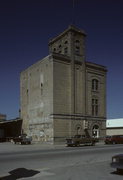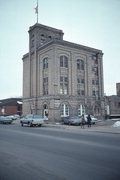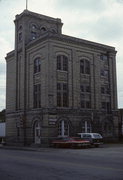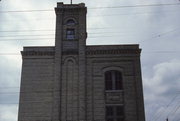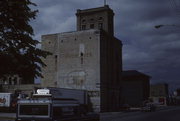Property Record
713 S MAIN ST
Architecture and History Inventory
| Historic Name: | FARMERS' BREWING CO. |
|---|---|
| Other Name: | Wright Broiler Co. |
| Contributing: | |
| Reference Number: | 22263 |
| Location (Address): | 713 S MAIN ST |
|---|---|
| County: | Shawano |
| City: | Shawano |
| Township/Village: | |
| Unincorporated Community: | |
| Town: | |
| Range: | |
| Direction: | |
| Section: | |
| Quarter Section: | |
| Quarter/Quarter Section: |
| Year Built: | 1914 |
|---|---|
| Additions: | |
| Survey Date: | 2000 |
| Historic Use: | brewery/distillery/winery |
| Architectural Style: | Romanesque Revival |
| Structural System: | |
| Wall Material: | Cream Brick |
| Architect: | Bernhard Barthell |
| Other Buildings On Site: | |
| Demolished?: | No |
| Demolished Date: |
| National/State Register Listing Name: | Not listed |
|---|---|
| National Register Listing Date: | |
| State Register Listing Date: |
| Additional Information: | A 'site file' exists for this property. It contains additional information such as correspondence, newspaper clippings, or historical information. It is a public record and may be viewed in person at the Wisconsin Historical Society, State Historic Preservation Office. 4 STORY ENGAGED TOWER W/BRICK CNR PILASTERS. 1ST FLR W/MASSIVE ROUND ARCH WINDOWS AND DOORS W/BRICK LINTELS. WALL BAYS DEFINED BY BRICK WALL PILASTERS. BRICK CORBELLED CORNICE TOPPED BY PLAIN PARAPET. SEGMENTAL ARCH 3RD FLR WINDOWS W/BRICK LINTEL COURSE. Buildings designed by Bernhard Barthell, an architect and engineer located in Chicago. Besides the brewery itself, the complex also consists of a separate but attached bottling works that fronts on S. Washington St. (ca.708). In 1913, a group of six German farmers organized the Farmers’ Brewing Company, which produced “Farmers Lager Beer” and later “Shawano Club.” To make brewing more efficient and economical, brewmaster Conrad Volland adopted special industrial designs that brewery architects in St. Louis and Chicago developed between the late 1870s and 1890. An organization of space along a vertical axis placed the water tanks, malt hopper, mash tub, brew kettle, and other equipment in a gravity-flow system. As the brewer introduced the water, malt, and hops at the top of the structure, the concoction flowed downward. In the final stages, the brewers transferred the beer to fermenting and lagering rooms. The Farmers’ Brewing Company Building exemplifies this spatial plan. At the top of the six-story tower was the primary tank, where the brewer created the wort. A brass cooling system stretched down from the fourth floor to a giant copper brewing kettle on the second. On that second floor stood six enormous stock tubs, with the first floor housing rows of fermenting tubs and seven huge storage tanks. Each of those tanks held the equivalent of 73 barrels of beer. The unknown builder constructed this building of cream brick in a Romanesque Revival style, specifically resembling the older Raddant Brewery that stood nearby on Fifth Street. A row of round-arch windows wraps around the top of the tower where the brewing process began. Several ancillary structures were also part of the brewery’s operations. Attached to the west is a one-story, brick keg house. This hyphen connects to a two-story storage area and engine house, which a pipe line connected to the two-story bottling works across the alley. The brick bottling-works features a stepped parapet and segmentally arched windows. |
|---|---|
| Bibliographic References: | Take a Walk on Main Street: Historic Walking Tours in Wisconsin's Main Street Communities, Wisconsin Main Street Program, 1998. Shawano County Advocate: 6/24/1913, p. 1; 7/01/1913, p. 1; 7/08/13, p. 1; 7/28, 1913, p. 1 (illustrated). Buildings of Wisconsin manuscript. |
| Wisconsin Architecture and History Inventory, State Historic Preservation Office, Wisconsin Historical Society, Madison, Wisconsin |

